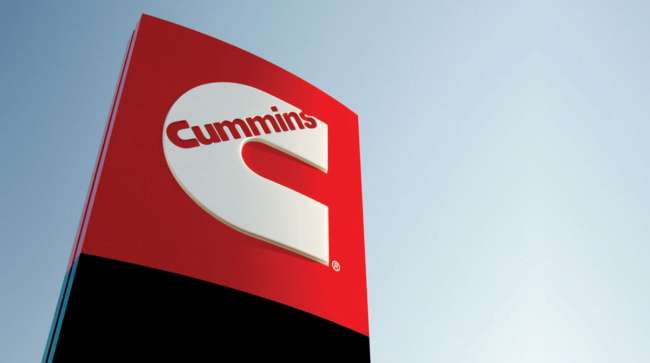Senior Reporter
Industry Shows Interest in Cummins’ Hydrogen Engines

[Stay on top of transportation news: Get TTNews in your inbox.]
Cummins Inc. is developing two hydrogen-fueled internal combustion engines that are scheduled for production in 2027, but fleets and others are already signing up for them.
Cummins has developed engines for various fuels — gasoline, natural gas, propane, diesel — over the years, and its engines are used by all U.S. truck makers and others.
“This is just the next flavor, hydrogen,” Jim Nebergall, general manager of Cummins’ hydrogen engine business, told Transport Topics.

Nebergall
The 6.7-liter and 15-liter hydrogen engines target a broad market: on-highway, construction and agriculture; anywhere that has challenging duty cycles, high fuel consumption and high-capacity utilization, he said.
“Hydrogen will have a dramatically lower NOx level than a diesel engine,” Nebergall said, “but it is also a huge greenhouse gas play.”
NOx (nitrogen oxide) is a generic term for the nitrogen oxides that are most relevant for air pollution. These gases contribute to the formation of smog and acid rain, as well as tropospheric ozone.
RELATED: Hydrogen Rises as Alternative Fuel, but Check the Feedstock
The word hydrogen is derived from Greek and means water maker. The byproduct a hydrogen ICE, or fuel cell, produces is water vapor, according to experts. But what feedstocks are used to produce hydrogen fuel determine its carbon intensity.
This is much like with batteries and the source of electricity to repower them — coal, natural gas, wind, hydro. Experts note the carbon and emission profiles of “clean” technologies can vary widely.
With the hydrogen ICE, there is a lower purchase price of the vehicle compared with a fuel cell-powered vehicle or a battery-electric equipped for a 500-mile range, Nebergall said.
He noted almost every major engine manufacturer in the world is looking at hydrogen for ICE.
“To me that’s just a sign of the seriousness of the technology and the potential viability,” Nebergall said.
Who's On Board?
Companies that have signlaed their readiness to adopt Cummins' hydrogen internal combustion engines:
• Werner Enterprises Inc.
• Transport Enterprise Leasing
• Buhler Industries Inc.
Werner Enterprises recently announced it signed a letter of intent to purchase 500 Cummins 15-liter hydrogen internal combustion engines when they become available.
Werner ranks No. 17 on the Transport Topics Top 100 list of the largest for-hire carriers in North America. It has about 8,800 tractors. The company also plans to validate the Cummins 15-liter natural gas engine along with the X15H,. Both are part of Cummins’ new fuel-agnostic engine platform.
Omaha, Neb.-based Werner’s stated goal is to reduce GHG emissions 55% by 2035.

Leathers
“Our customers are showing increased interest in more sustainable choices in the marketplace,” Chairman and CEO Derek Leathers said in a release. “We see significant potential in utilizing Cummins’ fuel-agnostic engine platform to continue the momentum toward reducing our carbon footprint.”
TEL, a commercial truck and trailer equipment lease and remarketing provider, reported it will integrate the X15H engines into its leased fleet of heavy-duty trucks.
Tractor maker Buhler has used Cummins’ engines exclusively in all four-wheel drive tractors since 1967, and new low- and zero-carbon solutions are ideally suited to farming, the company noted.
Potential customers know how to work on an ICE engine, Nebergall said, so the conversation quickly turns to “where the hydrogen fuel is available, what does the fuel infrastructure look like.”
As momentum grows for @Cummins' new 15-liter Hydrogen engine, @One_Werner has signed a letter of intent planning to secure 500 of these engines!
Read more: https://t.co/hnJ2WxlOw3 pic.twitter.com/ss2tXqe9QK — Cummins Inc. (@Cummins) September 7, 2022
Federal money is pouring into the space through the Inflation Reduction Act to drive down the cost of hydrogen fuel and provide other incentives for building stations, developing hydrogen hubs and related manufacturing. The engines and fuel cells are being readied as is the means of storing gaseous or liquid hydrogen on board trucks.
Hydrogen can be physically stored as either a gas or a liquid. Storage as a gas typically requires high-pressure tanks (5,000–10,000 pounds per square inch tank pressure). Storage of hydrogen as a liquid requires cryogenic temperatures because the boiling point of hydrogen at one atmosphere pressure is minus 252.8 degrees Celsius (or minus 423.04 degreesFahrenheit), the Department of Energy reported.

In this special edition of RoadSigns, hosts Seth Clevenger and Mike Freeze provide an inside look at Transport Topics' 2022 Top 100 Private Carriers list. Tune in above or by going to RoadSigns.ttnews.com.
The same Type 4 carbon fiber fuel tanks used for natural gas would be used for hydrogen, Nebergall said. The only difference is the storage pressure, which means there are thicker-walled tanks needed for hydrogen.
“All of the safety tests they have to go through are common with natural gas storage,” he said.
With liquid hydrogen, a truck could extend its range.
“It is something we are watching very closely,” Nebergall said. “I think it will be very interesting to see which of those two technologies win and where they apply.”
He said fueling stations would have to deliver both, and that’s a challenge, too.
“But it is very much in play. I don’t think we have a prediction on a winner,” Nebergall said. “I think [gaseous and liquid hydrogen] will have a place. It’s really about the onboard storage and what will be there at the time.”
Meanwhile, Cummins is heavily investing in hydrogen fuel cells, he said, as another viable solution for the commercial sector.
Cummins announced in May it will supply Class 8 market leader Freightliner, a brand of Daimler Truck North America, with a Cummins hydrogen fuel cell powertrain for Freightliner’s heavy-duty Cascadia model. Units will be available for select customers by 2024.
Cummins reported it spent $1.1 billion in 2021 on research and development, nearly doubling its previous budget, and most was for its decarbonization strategy.
Want more news? Listen to today's daily briefing below or go here for more info:




